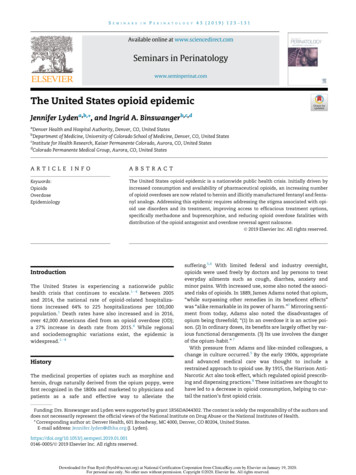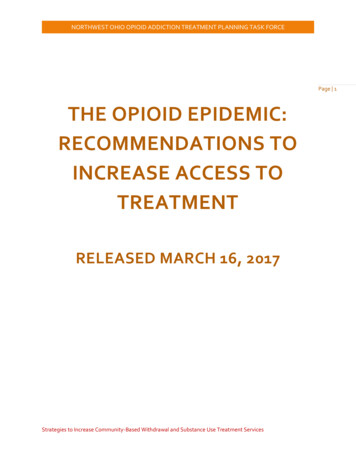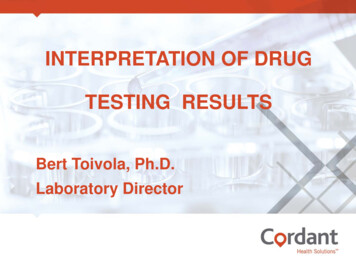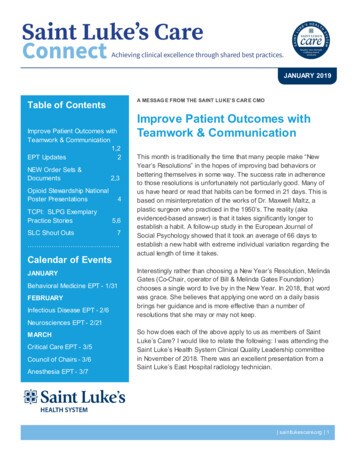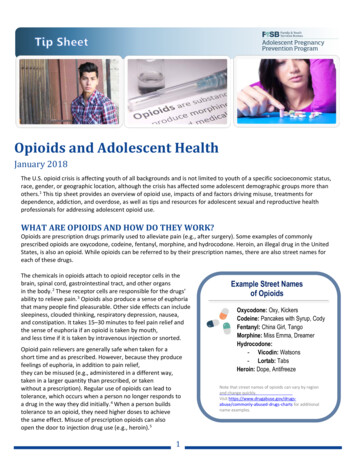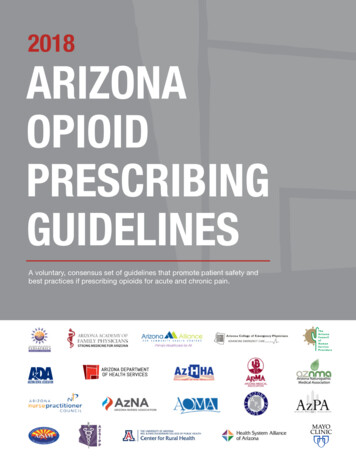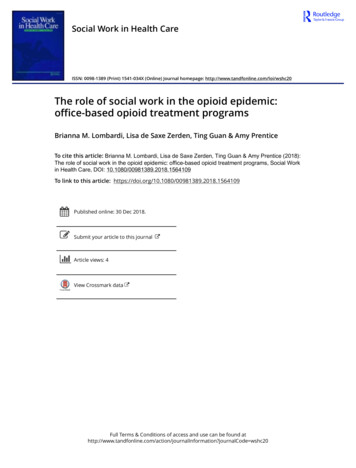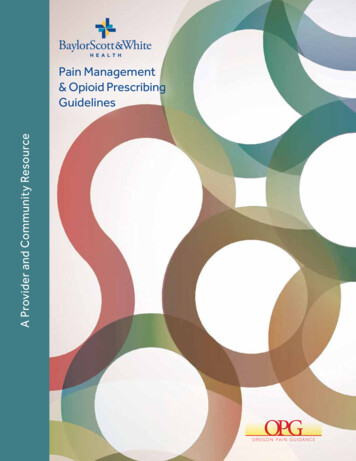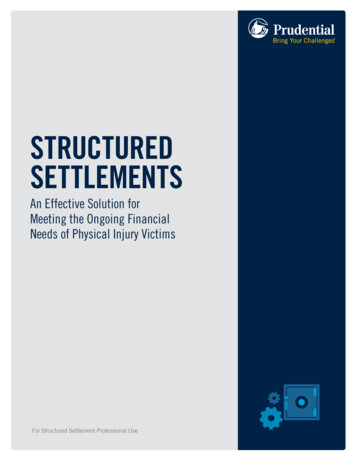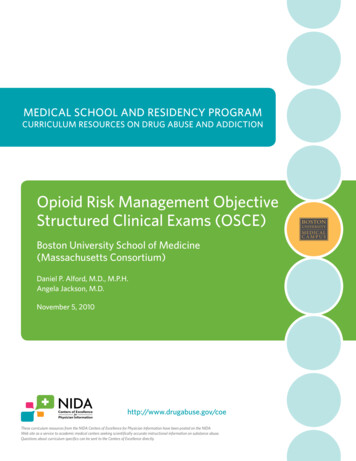
Transcription
Opioid Risk Management ObjectiveStructured Clinical Exams (OSCE)Boston University School of Medicine(Massachusetts Consortium)Daniel P. Alford, M.D., M.P.H.Angela Jackson, M.D.November 5, 2010These curriculum resources from the NIDA Centers of Excellence for Physician Information have been posted on the NIDAWeb site as a service to academic medical centers seeking scientifically accurate instructional information on substance abuse.Questions about curriculum specifics can be sent to the Centers of Excellence directly.
Opioid Risk ManagementObjective Structured Clinical Exams (OSCE)Boston University School of Medicine(Massachusetts Consortium)Written by:Daniel P. Alford, M.D., M.P.H.Angela Jackson, M.D.November 5, 2010Adapted with permission from Parish SJ, Ramaswamy M, Stein MR, Kachur EK, Arnsten JH. TeachingAbout Substance Abuse with Objective Structured Clinical Exams. J Gen Intern Med. 2006;21:453-459.These curriculum resources from the NIDA Centers of Excellence for Physician Information have been posted on the NIDA Web site as a service toacademic medical centers seeking scientifically accurate instructional information on substance abuse. Questions about curriculum specifics can besent to the Centers of Excellence directly. http://www.drugabuse.gov/coe
Table of ContentsIntroduction to Opioid Risk Management OSCE. 3Curriculum Module Components . 4Educational Objective . 5Facilitator Guide . 6OSCE Guide . 9Selected Bibliography . 10Pilot Information . 14Appendix A. Sample Patient Agreement Form . 16Appendix B. Learner Instructions for Each Station . 18Appendix C. Standardized Patient Instructions. 21Appendix D. Faculty – Learner Assessment Form . 30Appendix E. Learner Self-Assessment Form . 33Appendix F. Standardized Patient – Learner Assessment Form . 34Appendix G. Faculty OSCE Experience Evaluation Form . 35Appendix H. Learner OSCE Experience Evaluation Form . 36Appendix I. Standardized Patient (SP) OSCE Experience Evaluation Form . 372
Introduction to Opioid Risk Management OSCEOpioid risk management refers to efforts to minimize harms and maximize benefits of opioidsused in the treatment of chronic pain. Although opioid risk management education remainsinadequate in medical training curricula, residents frequently manage patients who require longterm opioid analgesics for chronic pain.Objective Structured Clinical Exams (OSCE) provide performance-based assessments ofclinical skills. This opioid risk management OSCE provides opioid risk managementcompetencies using standardized patients in realistic settings and immediate observer feedbackby trained faculty assessors. There are three stations covering important phases of managingpatients with chronic pain including (1) starting opioids; (2) assessing and addressing aberrantmedication-taking behaviors; and (3) assessing, monitoring, and addressing the risks andbenefits of long-term opioid analgesic therapy. At each station, the learner’s performance isassessed by faculty assessors using rating scales in three domains (general communication,clinical assessment, and clinical management) and two global items (general organization andoverall performance). The OSCE is targeted toward resident physicians in internal medicine andfamily medicine, but can be used to teach many levels of learners, including students, residents,or faculty.NIDA’s Center of Excellence for Physician Information offers the curriculum resource entitled,“Prescription Drug Abuse: An Introduction,” which serves as an introduction and overview toprescription drug abuse. It is available online: http://www.drugabuse.gov/coe.Key words: opioids; opioid risk management; chronic pain; drug addiction; substance abuse;prescription drug abuse3
Curriculum Module ComponentsThis curriculum resource module includes: Facilitator Guide OSCE Guide Sample Patient Agreement Form Learner Instructions for Each Station Standardized Patient Instructions Faculty – Learner Assessment Form Learner Self-Assessment Form Standardized Patient – Learner Assessment Form Faculty OSCE Experience Evaluation Form Learner OSCE Experience Evaluation Form Standardized Patient OSCE Experience Evaluation Form4
Educational Objective To assess learner’s opioid risk management competencies using standardized patients inrealistic settings and immediate observer feedback. These competencies include:--Starting a trial of opioid therapy using a patient agreement form to discussrisk/benefit and monitoring strategiesGiving a patient feedback regarding aberrant medication-taking behaviors (e.g.,escalation of dose, noncompliance with pill counts) with appropriate adjustmentin opioid therapy due to worsening painInterpreting and discussing abnormal urine drug test results with a patient anddiscussing the need for substance abuse treatment referralDiscussing lack of benefit (i.e., no substantial pain relief or improved function)and increased risk (i.e., opioid induced hyperalgesia, opioid withdrawal mediatedpain) in a patient with increasing pain despite increasing opioid doses anddeveloping a treatment plan that includes opioid taperTeaching PointsThe faculty assessor can assess learners on the following skills and whether the learnerperformed the accompanying behaviors. General Communication Skills / Relationship Development / Rapport Building- Allows patient to express self: uses open-ended questions, does not interrupt,invites questions- Communicates in nonjudgmental fashion: no leading questions, respectful, nonpatronizing- Exhibits empathic/supportive attitude: expresses concern, acknowledgespatient’s emotions/coping efforts, facilitative nonverbal behavior- Probes for resistance/denial: follows up on unclear statements- Uses language appropriate to patient’s level of understanding: avoids medicaljargon, explains unfamiliar medical terms- Strengthens treatment alliance: includes patient perspective in treatment plan Assessment and Management of Problem (station specific content)- Assesses for baseline opioid risk (screens for unhealthy substance (alcohol,drug, and tobacco) and consequences of substance use, asks about familyhistory of substance abuse)- Discusses risks and benefits of opioids for chronic pain (risks: physicaldependence, sedation, constipation, addiction, hyperalgesia ; benefits: modestimprovement in pain and function; discuss concern about using friend’s opioids)- Discusses universal monitoring strategies (opioid as a “test” not committing tolong-term opioids; controlled substance agreement; urine drug testing; pillcounts; includes response to aberrant medication taking behaviors –unsanctioned dose escalation, etc.; and short-term follow up arranged for pain/fctassessment and opioid monitoring)5
Facilitator GuideThe Objective Structured Clinical Exam (OSCE) is a timed, multi-station exercise that requireslearners to perform specific tasks in simulated clinical encounters using standardized patients.Performance is assessed at each station using predetermined rating scales by a small group offaculty assessors. The OSCE may serve as both an assessment tool and a formative exercise.The direct observation of learners “in action,” in the same clinical scenario, allows for aperformance-based assessment of learners’ skills. The immediate feedback offered, as well asthe opportunity for self-assessment, facilitates the enhancement or acquisition of knowledgeand skills.OSCEs do require dedicated blocks of time, as well as advanced planning and attention todetail for optimal execution, but are currently used widely in medical schools and residencyprograms. The stations described here may be easily incorporated into existing OSCEs at manyinstitutions, or added to existing didactic sessions, seminars, academic half days, or ambulatoryblocks. This OSCE includes the following components. Three OSCE station cases with 1) learner instructions [Appendix B] and 2) standardizedpatient instructions [Appendix C]- Station 1: Starting opioid therapy for chronic noncancer pain- Station 2: Managing a patient with aberrant medication-taking behaviors- Station 3: Discontinuing opioids due to lack of benefit and increased risks Assessment of learner’s performance forms- Faculty assessment of learner form [Appendix D]- Learner self-assessment form [Appendix E]- Standardized patient assessment of learner form [Appendix F] OSCE exercise evaluation forms- Faculty assessor OSCE evaluation form [Appendix G]- Learner OSCE evaluation form [Appendix H]- Standardized patient OSCE evaluation form [Appendix I]Faculty Training Three to six faculty members in internal medicine will be selected to serve as facultyassessors of learners’ performance for the OSCE. The faculty assessors should haveexperience as clinician educators and with giving learners feedback following directobservation of clinical encounters. Faculty should have expertise in substance abuseand pain management in the ambulatory setting. All faculty will participate in a 20-minute small group discussion of effective feedbackdelivery. Faculty will role play each station-specific case to standardized ratings, agree onteaching points, and practice giving station-specific feedback. This 90 minute sessionincludes the following steps:- The logistics of the sessions are reviewed.- Faculty rotate through all of the stations in groups of three. One facultymember takes on the learner’s role, another faculty member assumes thefaculty assessor’s role, while the third serves as the observer.6
-The rating forms are completed for each station and reviewed anddiscussed with the faculty assessors. Faculty assessors review the keycomponents to determine when the learners have completed their taskssuccessfully and met the learning objectives, guided by the standardizedrating forms.Standardized Patient (SP) Selection and Training Some institutions have access to standardized patient programs, which providean attractive, although sometimes costly, option for the OSCE. Other institutionsrecruit, from local professional acting groups, actors that are appropriate to theroles as written (e.g., age, gender), or use hospital or medical school personnelas volunteers, after first ensuring that they are not known to the learners (e.g.,from different departments in the hospital). SPs practice with faculty assessors to standardize performance and feedback.Learner Introduction to Opioid Risk Management OSCE Learners participate in the OSCE after attending teaching sessions onprescription drug abuse and receiving an overview of pain management. NIDA’sCenter of Excellence for Physician Information offers the curriculum resourceentitled, “Prescription Drug Abuse: An Introduction. This resource includes a 60minute prescription drug abuse case-based lecture and a 90-minute interactivediscussion on management of chronic pain in the ambulatory setting. It providesan overview of prescription drug abuse, framed within the common clinicalscenario of chronic pain management in the outpatient settings. It is availableonline: http://www.drugabuse.gov/coe. Additional curriculum resources on prescription drug abuse are also availablefrom NIDA. These resources, including can be found here:http://www.drugabuse.gov/coe/topic.htm#pda. For additional information on prescription drug abuse, please go to the NationalInstitute on Drug Abuse’s NIDAMED Web iption.html Learners attend a 20-minute OSCE introduction session outlining learningobjectives and logistics of each station (as described below).Administration of the Opioid Risk Management OSCE Learners rotate through all three stations; each station experience takes 25minutes.- Learners have 2 minutes before each station to read the station-specificlearner instruction sheet posted outside of each station’s exam room andthe specific tasks to be accomplished.- Learners have 10 minutes to assess and manage the particular casewhile a faculty assessor completes a rating form.- At the end of each encounter, learners self-assess their performance in 2minutes and the standardized patient gives a brief assessment in 1minute. The faculty assessor then provides 10 minutes of directfeedback based on predetermined teaching points.7
The learner, standardized patient, and faculty assessor will complete the learnerassessment forms.OSCE Evaluation Faculty assessors, learners, and standardized patients complete an evaluation ofthe OSCE experience, focusing on process, logistics, and learning opportunities. Learners and faculty assessors participate in a 20-minute group debriefingsession to discuss the pros and cons of the OSCE experience and anyimprovements that can be made to the content and/or process.8
OSCE Guide2 minRead case [visit scenario and specifics tasks (3 tasks per station)]10 minPatient interview (1 min warning to “wrap things up”)1 minLearners self evaluate“What was the most challenging part of this interview?”1 minStandardized patient to evaluate“How did the interaction feel to you?”5 minFaculty observer to give feedback Communication skills Assessment and management of the problem1Complete assessment formsLearners move to the next stationminFaculty role Keep things on schedule Give corrective and reinforcing feedback to learner Complete learner assessment form after each session and hand in at end ofOSCE Collect assessment forms from SP and hand in at the end of the OSCE Give standardized patient some feedback between sessions Complete OSCE evaluation form (remember this is a pilot ------------------------OSCE Overhead Announcements0:00 / 20:001:001:302:0011:0012:0018:0019:00“Next Station, Read Case”“1 Minute More for Case”“30 Seconds More for Case”“Stop Reading Case, Enter Room, Start Interview Now”“Wrap Up Interview, 1 Minute”“Stop Interview, Start Feedback Now”“Wrap Up Feedback, 1 Minute”“Stop Feedback, Complete Forms”9
Selected BibliographyThis bibliography provides additional resources to faculty who are interested in reading moreabout addiction medicine and learning more on the background of some of the concepts taughthere.Opioids and Chronic PainArnold R, Han PK, Seltzer D. Opioid contracts in chronic nonmalignant pain management:objectives and uncertainties. Am J Med. 2006;119(4):292–296Aronoff GM. Opioids in chronic pain management: Is there a significant risk of addiction?Current Review of Pain. 2000;4:112–121Ballantyne JC, Mao J. Opioid therapy for chronic pain. NEJM 2003; 349: 1943–-1953Chabal C, Erjavec MK, Jacobson L et al. Prescription opiate abuse in chronic pain patients. ClinJ Pain. 1997; 8:77–85.Chou R et al. Clinical guidelines for the use of chronic opioid therapy in chronic noncancer pain.J of Pain. 2009;10:113–130Chou R, Huffman LH, American Pain Society American College of Physicians. Medications foracute and chronic low back pain: A review of the evidence for an American PainSociety/American College of Physicians clinical practice guideline. Ann Intern Med.2007;147(7):505–514.Cole BE. Recognizing preventing and medication diversion. Family Practice Management.2001;8:37–41.Dworkin RH, Turk DC, Farrar JT, et al. Core outcome measures for chronic pain clinical trials:IMMPACT recommendations. Pain. 2005;113:9–19.Evers GC. Pseudo-opioid-resistant pain. Supportive Care in Cancer. 1997;5(6):457–460Federation of State Medical Boards of the United States, Inc. Model policy for the use ofcontrolled substances for the treatment of pain. Journal of Pain and Palliative CarePharmacotherapy. 2005;19:73–78.Fishbain DA, Cutler RB, Rosomoff HL, Rosomoff RS. Validity of self-reported drug use inchronic pain patients. Clin J Pain. 1999;15:184–191.Fishman SM, Kreis PG. The opioid contract. Clin J Pain. 2002; 18(4 Suppl):S70–S75Gourlay DL, Heit HA, Almahrezi A. Universal precautions in pain medicine: A rational approachto the treatment of chronic pain. Pain Medicine 2005;6(2):107–112Gourlay DL, Heit HA. Risk management is everyone’s business. Pain Medicine. 2007;8:125-12710
Hammett-Stabler CA, Pesce AJ, Cannon DJ. Urine drug screening in the medical setting.Clinica Chimica Acta. 2002;315:125–135.Heit HA, Gourlay DL. Urine drug testing in pain medicine. J Pain Symptom Manage.2004;27:260–267.Heit HA, Gourlay DL, Caplan YH, eds. Urine Drug Testing in Primary Care: Dispelling the Mythsand Designing Strategies. PharmCom Group, Inc., 2006.Heit HA. The truth about pain management: the difference between a pain patient and anaddicted patient. European J of Pain. 2001: 5 (suppl A):27–29.Inturrisi CE. Clinical pharmacology of opioid for pain. Clin J Pain. 2002;18: S3-S13.Isaacson JH. Preventing prescription drug abuse. Cleveland Clinic J Med. 2000.67:473–-475.Isaacson JH, Hopper JA, Alford DP, Parran T. Prescription drug use and abuse: Risk factors,red flags and prevention strategies. Postgrad Med. 2005; 118:19–26.Johnson MD, Heriza TJ, St. Dennis C. How to spot illicit drug abuse in your patients. PostgradMed. 1999;106:199–218.Katz NP et al. Foundations of opioid risk management. Clin J Pain. 2007;23:103–118Katz NP, Sherburne S, Beach M, et al. Behavioral monitoring and urine toxicology testing inpatients receiving long-term opioid therapy. Anesthesia and Analgesia. 2003;97:1097–1102Katz N, Fanciullo GJ. Role of urine toxicology testing in the management of chronic opioidtherapy. Clin J Pain. 2002; 18(4 Suppl):S76–S82Kouyanou K, Pither CE, Wessely S. Medication misuse, abuse and dependence in chronic painpatients. J Psychosomatic Res. 1997;43:497–504.Kuehn BM. Efforts aim to curb opioid deaths, injuries. JAMA. 2009;301:1213–1215Manchikanti L, Atluri S, Trescot AM, Giordano J. Monitoring opioid adherence in chronic painpatients: tools, techniques and utility. Pain Physician. 2008; 11: S155-S180Martell BA, O’Connor PG, Kerns RD, Becker WC, Morales KH, Kosten TR, Fiellin DA.Systematic review: Opioid treatment for chronic back pain: prevalence, efficacy, andassociation with addiction. Ann Intern Med. 2007;146(2):116–127Michna E, Ross EL, Hynes WL, Nedeljkovic SS, Soumekh S, Janfaza D, Palombi D, JamisonRN. Predicting aberrant drug behavior in patients treated for chronic pain: importance ofabuse history. J Pain Symptom Manage. 2004;28(3):250–258Mitka M. Abuse of prescription drugs: is a patient ailing or addicted? JAMA. 2000;283:1126–1128.11
Mitra S, Sinatra RS. Perioperative management of acute pain in the opioid-dependent patient.Anesthiosology. 2004;101:212-227Olsen Y, Alford DP. Chronic Pain Management in Patients With Substance Use Disorders.Advanced Studies in Medicine. 2006; 6(3):111–123.Olsen Y, Daumit GL, Ford DE. Opioid prescriptions by U.S. primary care physicians from 1992to 2001. J of Pain. 2006; 7(4):225–235Olsen Y, Daumit GL. Opioid prescribing for chronic nonmalignant pain in primary care:challenges and solutions. Advances in Psychosomatic Medicine. 2004; 25:138–150Parran TV. Prescription drug abuse: a question of balance. Med Clin North Am 1997. 81:967–978.Passik SD. Issues in long-term opioid therapy: unmet needs, risks, and solutions. Mayo ClinProc. 2009;84(7):593–601.Passik SD, Kirsh KL, Whitcomb L, Schein JR, Kaplan MA, Dodd SL, Kleinman L, Katz NP,Portenoy RK. Monitoring outcomes during long-term opioid therapy for noncancer pain:results with the Pain Assessment and Documentation Tool. Journal of OpioidManagement. 2005;1(5):257–66Passik SD. Kirsh KL. Managing pain in patients with aberrant drug-taking behaviors. TheJournal of Supportive Oncology. 2005; 3(1):83–6Reid MC, Engles-Horton LL, Weber MB, Kerns RD, Rogers EL, O’Connor PG. Use of opioidmedications for chronic noncancer pain syndromes in primary care. J Gen Intern Med.2002; 17(3):173–179Savage SR Joranson DE, Covington EC, Schnoll SH, Heit HA, Gilson AM. Definitions related tothe medical use of opioids: Evolution towards universal agreement. J Pain SymptomManage. 2003;26:655–667Savage SR. Addiction in the treatment of pain: significance, recognition and management. JPain Symptom Manage. 1993;8:265–278Schnoll SH, Weaver MF. Addiction and pain. Am J Addict. 2003;12(suppl 2):S27-S35Weissman DE, Haddox JD. Opioid pseudoaddiction-an iatrogenic syndrome. Pain.1989;36:363–366.Trescot AM, Boswell MV, Atluri SL, et al. Opioid guidelines in the management of chronic noncancer pain. Pain Physician. 2006;9:1–39.Turk DC, Swanson KS, Gatchel RJ. Predicting opioid misuse by chronic pain patients. Asystematic review and literature synthesis. Clin J Pain. 2008;24:497–508.Upshur CC, Luckmann RS, Savageau JA. Primary care provider concerns about managementof chronic pain in community clinic populations. J Gen Intern Med. 2006;21(6):652–655.Von Korff M, Ormel J, Keefe FJ, Dworkin SF. Grading the severity of chronic pain. Pain.1992;50:133–149.12
Weissman DE,. Haddox JD. Opioid pseudoaddiction—An iatrogenic syndrome. Pain.1989;36(3):363–366White JM. Pleasure into pain. The consequences of long-term opioid use. Addictive Behaviors.2004;29:1311–1324.Objective Structured Clinical ExaminationAnderson MB, Still PL, Wang Y. Growing use of standardized patients in teaching andevaluation in medical education. Teach Learn Med. 1994;6:15–22Dupras DM, Li JT. Use of an objective structured clinical examination to determine clinicalcompetence. Acad Med. 1995;70:1029–1034Harden RM, Gleason FA. Assessment of clinical competence using an objective structuredclinical examination. Med Educ. 1979;13:41–47Hodder RV, Rivington RN, Calcutt LE. The effectiveness of immediate feedback during theobjective structured clinical examination. J Med Educ. 1989;23:184–188Parish SJ, Ramaswamy M, Stein MR, et al. Teaching about substance abuse with objectiveclinical exams. J Gen Intern Med. 2006;21:453–459Wilson BE. Performance-based assessment of internal medicine interns: evaluation of baselineclinical and communication skills. Acad Med. 2002;77:115813
Pilot InformationTEACHING OPIOID RISK MANAGEMENT (ORM) SKILLS TO RESIDENTSD.P. Alford,1 B. Brett,2 A.H. Jackson,11Boston University School of Medicine and Boston Medical Center, Boston, MA;2 BrettConsulting Group, Somerville, MASTATEMENT OF PROBLEM: Chronic pain is a leading complaint for which adults seek medicalcare, and opioid analgesics are increasingly being prescribed. The rate of prescription opioidmisuse, including addiction, unintentional overdoses, and diversion, is increasing. Inadequatemedical education about opioid risk management for patients with chronic pain could becontributing to this problem.OBJECTIVES OF THE PROGRAM: To increase internal medicine residents’ knowledge andskills in opioid risk management (ORM).DESCRIPTION OF THE PROGRAM: We developed a two-part ORM education program.Part A–Didactic: 1-hour lecture covered assessment of pain, function, addiction risk andpotential opioid benefit/risk; monitoring for opioid benefit/risk; developing exit strategies for lackof benefit/increased risk; and developing effective communication skills on these topics.Part B–Objective Structured Clinical Exams (OSCE): Three 20-minute stations usingstandardized patients in realistic settings and immediate faculty observer feedback. The stationscovered ORM skills, including starting opioid therapy, giving patients feedback regardingaberrant medication-taking behaviors, and discussing opioid taper due to lack ofbenefit/increased risk.The educational program was evaluated by comparing three groups of residents selected byconvenience sampling: Group 1 (n 20) participated in the didactic session only, Group 2 (n 9)participated in both the didactic and OSCE sessions, and Group 3 (n 10), a control group, didnot participate in either session. All three groups completed a baseline survey composed ofthree components: knowledge, clinical confidence,* and practice. Groups 1 and 2 completed apost-didactic survey to detect changes in knowledge from baseline. Group 2 completed a postOSCE survey assessing clinical confidence to detect changes from baseline. Group 2 alsocompleted an evaluation of the OSCE experience. All three groups are scheduled to complete4- and 8-month follow-up surveys (identical to the baseline survey) asking about ORMknowledge, clinical confidence, and practice.FINDINGS TO DATE/EVALUATION: The total resident sample (n 39) was 51 percent female,38 percent PGY1, 36 percent PGY2, and 26 percent PGY3. At baseline: 31 percent reported no previous training in the use of opioids for managing chronic pain;74 percent reported that their prior ORM training was not enough; and23 percent reported starting patients on long-term opioids in the past three months.* The information about clinical confidence was obtained using the evaluation tools—self-report,surveys—used to assess the earlier intervention, which was an OSCE for residents.14
Baseline differences in ORM clinical confidence/practice were not significant between the threestudy groups.Post-didactic ORM knowledge scores (max score 4) increased for Group 1 (didactic only) from2.7 to 3.3 (p .05), while Group 2 (didactic OSCE) changed from 3.2 to 3.7, a non-significantchange. For Group 2, the pilot’s post-OSCE mean clinical confidence (8 ORM skills using 5point Likert scale) increased from 2.8 to 3.8 (p .002). Group 2 all reported that the OSCE“helped me identify my strengths and weaknesses,” “taught me something new,” and “was avaluable learning tool.”KEY LESSONS LEARNED: Internal medicine residents are not very confident about initiatingand managing long-term opioid pain therapy in patients with chronic pain. A didactic session onthe topic can increase knowledge. A related OSCE provides additional valuable experience indeveloping skills needed to communicate effectively with patients suffering from chronic pain onlong-term opioids.15
Appendix A. Sample Patient Agreement FormPatient Name:Medical Record Number:Addressograph Stamp:AGREEMENT FOR LONG TERM CONTROLLED SUBSTANCE PRESCRIPTIONSThe use of (print namesof medication(s)) may cause addiction and is only one part of the treatmentfor: (print name condition—e.g., pain, anxiety, etc.).The goals of this medicine are: to improve my ability to work and function at home. to help my (print name of condition—e.g., pain, anxiety, etc.)as much as possible without causing dangerous side effects.I have been told that:1.If I drink alcohol or use street drugs, I may not be able to think clearly and I couldbecome sleepy and risk personal injury.2.I may get addicted to this medicine.3.If I or anyone in my family has a history of drug or alcohol problems, there is a higherchance of addiction.4.If I need to stop this medicine, I must do it slowly or I may get very sick.I agree to the following: I am responsible for my medicines. I will not share, sell or trade my medicine. I will nottake anyone else’s medicine.I will not increase my medicine until I speak with my doctor or nurse.My medicine may not be replaced if it is lost, stolen, or used-up sooner than prescribed.I will keep all appointments set up by my doctor. (Primary Care, physical therapy, mentalhealth, substance abuse treatment, pain management, etc.)I will bring the pill bottles with any remaining pills of this medicine to each clinic visit.I agree to give a blood or urine sample, if asked, to test for drug use.RefillsRefills will be made only during regular office hours—Monday through Friday, 8:00AM-4:30 PM.No refills on nights, holidays or weekends. I must call at least three (3) working days ahead (MF) to ask for a refill of my medicine. No exceptions will be made. I will not come to PrimaryCare for my refill until I am called by the nurse.I must keep track of my medications. No early or emergency refills may be made.PharmacyI will only use one pharmacy to get my medicine. My doctor may talk with the pharmacist aboutmy medicines.The name of my pharmacy is .16
Prescriptions from Other DoctorsIf I see another doctor who gives me a controlled substance medicine (for example, adentist, a doctor from the Emergency Room or another hospital, etc.) I must bring thismedicine to Primary Care in the original bottle, even if there are no pills left.PrivacyWhile I am taking this medicine, my doctor may need to contact other doctors or familymembers to get information about my care and/or use of this medicine. I will be asked tosign a release at that time.Termination of AgreementIf I break any of the rules, or if my doctor decides that this medicine is hurting me more thanhelping me, this medicine may be stopped by my doctor in a safe way.I have talked about this agreement with my doctor and I understand t
Web site as a service to academic medical centers seeking scientifically accurate instructional information on substance abuse. Questions about curriculum specifics can be sent to the Centers of Excellence directly. Opioid Risk Management . Objective Structured Clinical Exams (OSCE) . Complete OSCE evaluation form (remember this is a .
